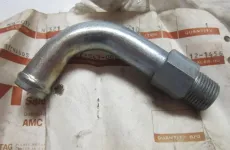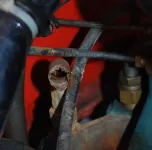Where is this coolant coming from?
007
Crazy Sr. Respected Jeeper
- Posts
- 3,451
- Media
- 5
- Solutions
- 1
- Thanks
- 64
- Location
- Reno, NV
- Vehicle(s)
- 1977 CJ-7 Renegade (Daisy Jane), Levis trim, 304, TH400, BW1339 (MM), D30/Auburn Max, AMC20/Detroit/G2's, 4.88's, 33" BFG MT KM2's, Edelbrock Performer intake, Holley Sniper 4bbl EFI, MSD6, MSD ProBillet distributor, OME shocks, 4" ProComp lift.
I was laying underneath my jeep last night replacing a couple Transmission lines. Well I was underneath there a drop of coolant landed on my arm. I looked up and the whole passenger side exhaust manifold is covered in it. It almost looks as if it's coming out of the two bolts there in the center as part of the emissions.
This picture is looking straight up from the bottom the shiny part is part of the starter.

This next picture is looking through the wheel well.

And lastly I found this plug on the side of the block on the passenger-side could this be a block heater?

Sent from my iPhone using Tapatalk
This picture is looking straight up from the bottom the shiny part is part of the starter.

This next picture is looking through the wheel well.

And lastly I found this plug on the side of the block on the passenger-side could this be a block heater?

Sent from my iPhone using Tapatalk





